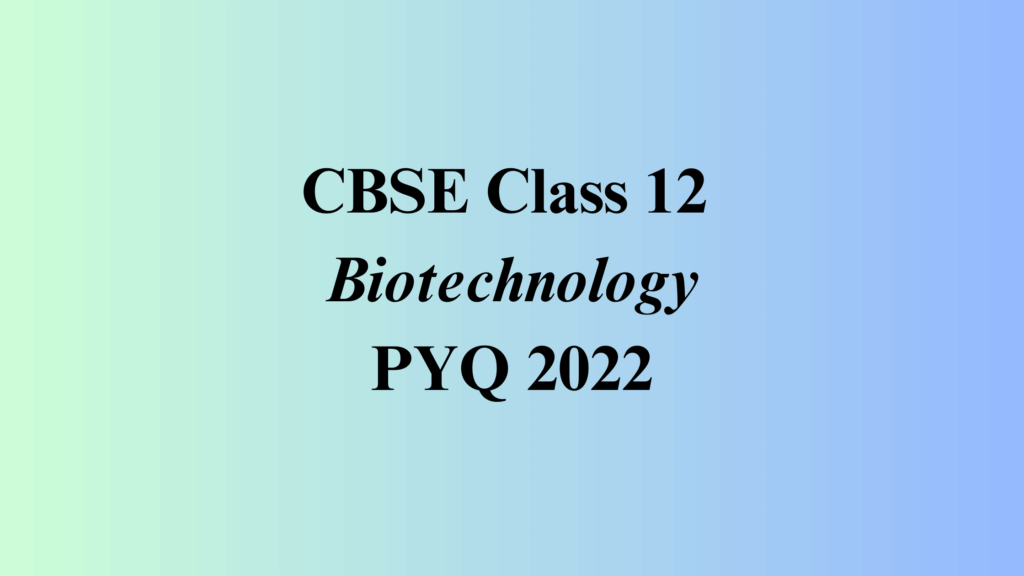Class 12 Biotechnology PYQ 2022 Solved
Time allowed: 3 hours
Maximum Marks: 70
SECTION A
1. Construct a flowchart showing the action of t-PA (tissue plasminogen activator). 2
Ans:
Plasminogen ➝ Plasmin ➝Fibrin ➝ Dissolution of blood clot
(Inactive
precursor
enzyme)
OR
Plasminogen ➝ Plasmin ➝ Fibrin ➝ Dissolution of blood clot
(Inactive precursor tPA degrade
enzyme)
2. Why can foaming cause problems in microbiological processes ? 2
- Foaming denatures protein
- Foaming provides a hindrance to the free diffusion of oxygen in the medium
3. What information can be obtained from the following Database retrieval tools ? 2
(a) Locus link
(b) Taxonomy browser
(a) Locus Link
- Carries information on the official gene name and descriptive information about genes.
- With the help of Locus Link, one can access the information on homologous genes. (Any 1)
(b) Taxonomy Browser
- Provides information on the taxonomic classification of various species.
- The taxonomy database has information on over 79,000 organisms. (Any 1)
4. (a) Ripening of fruits has been slowed down to prevent their spoilage during transportation. How ? 2
The gas hormone, Ethylene is involved in the regulation of fruit ripening. Ripening of fruits can be slowed down by blocking or reducing ethylene production. This can be achieved by introducing ethylene forming gene(s) in a way that it will suppress its own expression in the crop plant.
OR
(b) Plants have adapted to cope with abiotic stress conditions. How ? 2
Plants have adapted to cope with abiotic stress conditions by producing stress-related osmolytes like sugars (e.g., trehalose and fructans), sugar alcohols (e.g., mannitol) and amino acids (e.g., proline), glycine, betaine, and certain proteins (e.g., antifreeze proteins) (Explanation with any 2 examples )
5. (a) What is Golden Rice? How is it developed? 2
- Golden rice is a yellow colored genetically engineered rice which is enriched in provitamin A (beta-carotenoids).
- It is developed by introducing three genes involved in the biosynthetic pathway for carotenoid under the control of endosperm endosperm-specific promoter, so that the gene products (enzymes) are synthesized in the rice endosperm.
OR
(b) What are Cybrids? Name any two cytoplasmic traits that can be transferred using Cybrids, from one plant species to another. 2
- Cybrids are cytoplasmic hybrids produced through protoplast fusion in which the genome of one partner is lost i.e., fusion of nucleated and enucleated protoplasts of different species / Alternatively, The isolated and purified organelles (chloroplasts or mitochondria) from one species can be fused with the recipient protoplasts from a different plant species (known as organelle transfer or organelle uptake). (Any 1 method)
- Cytoplasmic traits :
- Herbicide Tolerance
- Cytoplasmic male sterility
(PHB, pollen formation/ suppression, leaf variegation, flower colour such as blue rose, caffeine free coffee, blue cotton, tearless onion (Points from topic other applications as on Pgs. 131, 132) (Any of these traits can also be considered)
6. Enlist important differences between finite and continuous cell lines. 2
Finite cell lines:- Cells show limited life span, contact inhibition, density limitation, anchorage dependence, mode of growth is monolayer, a slow growth rate, a doubling time is around 24- 96 hours, a normal shape of cells, number of chromosomes in cells does not change. (Any 2)
Continuous cell lines:- Cells show no contact inhibition, no anchorage dependence, reduced or lost density limitation, mode of growth is either monolayer or suspension form, rapid growth rate, doubling time is between 12 – 24 hours, more rounded shape of cells, no of chromosomes in cells may change. (Any 2)
SECTION B
7. (a) Why is regulation of pH important for survival of mammalian cells in culture? Write two reasons.
(b) How does bicarbonate CO2 buffering system work? 3
(a) Regulation of pH is important for the survival of mammalian cells in culture for:-
- Maintaining appropriate ion balance
- Maintaining the optimal function of cellular enzymes
- Optimal binding of hormones and growth factors to cell surface receptors (Any 2)
(b) The interaction of CO2 derived from cells or the atmosphere with water leads to a drop in pH as described by the equation below:
H2O + CO2 ↔ H2CO3 ↔ H+ + HCO3–
The bicarbonate content of the medium neutralizes the effect of increased CO2 according to the following equation:
NaHCO3 ➝ Na+ + HCO3–
The increased HCO3- ion drives the equation above to the left until the equilibrium is reached at pH 7.4.
8. What is RefSeq? Give its significance. (any 2 points) 3
- RefSeq is a curated database of mRNA and proteins of organisms like human, mouse, and rat / RefSeq is one of the several tools among the resources for gene-level sequences.
- Significance: 1. Designing gene chips.
- 2. Describing the sequence features of the human genome.
9. (a) A medium for microbial culture contains components like peptone, meat extract, yeast extract, casein digest, and corn steep liquor. This culture medium is a complex medium. Why?
(b) Why is agar added to any nutrient medium?
(c) What are the conditions for sterilization of culture medium in an autoclave? 3
- (a) The culture medium is complex because the exact chemical composition is not known.
- (b) Agar is added for the solidification of the nutrient medium.
- (c) Autoclaving at a pressure of 15 pounds psi (per square inch) for 15 – 20 minutes (at 121 °C temperature).
10. (a) Animal cell cultures are placed in CO2 incubators, as they help to reproduce environmental conditions close to the living cells. How? 3
CO2 incubators help to maintain the following conditions:-
- Sterility of the chamber
- Constant temperature
- Atmosphere with a fixed level of carbon dioxide (5-10% CO2)
- High relative humidity
- Correct osmolarity
- To prevent the desiccation of culture medium (any 3)
OR
(b) Serum is an important component of animal cell culture. Support the statement giving two reasons. Why are antibiotics added to culture medium? 3
Serum is an important component of animal cell culture because it:-
- Supports cell proliferation
- Helps in the attachment of cells to culture vessels
- It is a source of peptide hormones or hormone-like growth factors that promote healthy growth
- It is a source of various amino acids, hormones, vitamins, lipids, polyamines, and salts such as calcium, chloride, ferrous, ferric, potassium, etc (any 2)
Antibiotics are added to culture medium to control the growth of bacterial and fungal contaminants.
11. How can a farmer eliminate the process of emasculation to prevent unnecessary pollination in his maize crop? Can normal pollen formation be ensured at the onset of breeding seasons? 3
- Farmers can eliminate the process of emasculation by introducing male sterile maize plants in the field. Male sterile plants are created by introducing a bacterial gene from Bacillus amyloliquefaciens that encodes an enzyme barnase, which is an RNA-hydrolyzing enzyme that inhibits pollen formation. This gene is expressed specifically in the tapetal cells of anther using tapetal-specific promoter (e g., TA29).
- Yes / By introducing another gene from the same bacterium under the control of TA29, whose product barstar (protein) tightly binds with RNase so that normal pollens are formed. / By using the barnase-barstar system / By producing male sterile-restorer lines.
12. Draw a labelled diagram of an artificial seed. Why are these seeds produced? 3
Diagram and correct labelings of A, B and C
Artificial Seeds are produced for rapid and mass propagation of elite plant species as well as hybrid varieties in a short time.
(For Visually Impaired Candidates Only)
What are artificial seeds? Why are they produced? 3
- Artificial seeds are synthetic seeds or somatic seeds. They are produced either by encapsulating the somatic embryos in a protective covering i.e., calcium alginate beads or by desiccating the somatic embryos with or without coating.
- Artificial seeds are produced for rapid and mass propagation of elite plant species as well as hybrid varieties in a short time.
SECTION C
13. (a) Microbial Cultures :
Microbial cultures have immense potential for production of very useful compounds. These cultures can be exploited mainly to produce different metabolites which include enzymes, steroids, antibiotics, therapeutic proteins, microbial leaching, biodegradable waste treatment, etc.
(i) Give an example where microbial metabolism has been used to convert unsuitable substrates to useful products. 1
(ii) Define DSP. Why is it advisable to use less number of steps in a DSP protocol? 1
(iii) What are excipients? 1
(iv) Which organisms are referred to as GRAS? 1
(v) Briefly mention two biosafety issues specific in microbial technology. 1
- (i) Extraction of metal ores / Treatment of liquid waste
- (ii) Separation / Recovery / Isolation / Purification of metabolites from fermented broth with or without cell disruption is known as Downstream Processing (DSP).
Less number of steps is advised:- To achieve the desired purity/ To maximize yield/ To reduce cost /To prevent product loss
- (iii) Excipients are several ingredients that are added to a pure metabolite to obtain a stabilized formulation.
- (iv) GRAS:- Organisms which are generally regarded as safe. These organisms are non-allergic, non-toxic, non-pathogenic, and generally do not produce any antibiotics.
- (v) Biosafety issues specific to Microbial technology are:-
- Potential of pathogenicity and infection by recombinant strains
- Toxicity and allergy are associated with the use of microbially produced recombinant molecules.
- Transfer of antibiotic-resistant genes or to increase the environmental pool of antibiotic-resistant microorganisms
- Problems associated with the disposal of spent microbial biomass
- Safety aspects associated with contamination, infection or mutation of process strains. (Any 2 or any other relevant point can be considered)
OR
(b) Continuous Culture :
To get a continuous supply of microbial growth, continuous culture is used. The growth medium is designed in such a way that one of the nutrients is in limited quantity. Nutrients are continually added to the bioreactor, and spent culture broth is removed at the same time. This culture helps to obtain stable product quality and higher productivity per unit volume, so this technique is widely
used for the production of both microbial biomass as well as their metabolites.
(i) Differentiate between turbidostat and chemostat. 2
(ii) Which type of microbial culture is shown in this graph? 1
- (i) Turbidostat: Maintains constant cell concentration.
Chemostat: Maintains a constant chemical environment
- (ii) Fed Batch culture
(iii) How is continuous culture different from Fed-Batch culture in terms of volume in the culture vessel? In which type of method can microbial culture be maintained in an extended log or stationary phase? 1+1
- In Continuous culture, the volume in the culture vessel remains constant whereas in Fed-batch culture, the volume in the culture vessel goes on increasing.
- The microbial culture is maintained in an extended log or stationary phase in continuous culture.
Additional Study Materials
- Class 12 Biotechnology Syllabus 2025-26
- Class 12 Biotechnology Question Paper 2024
- Class 12 Biotechnology PYQ 2023 Solved




